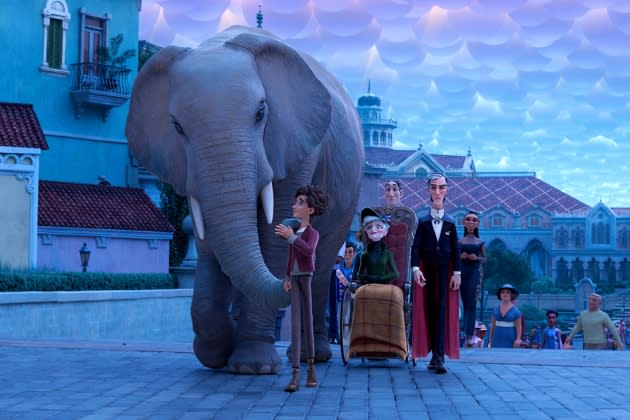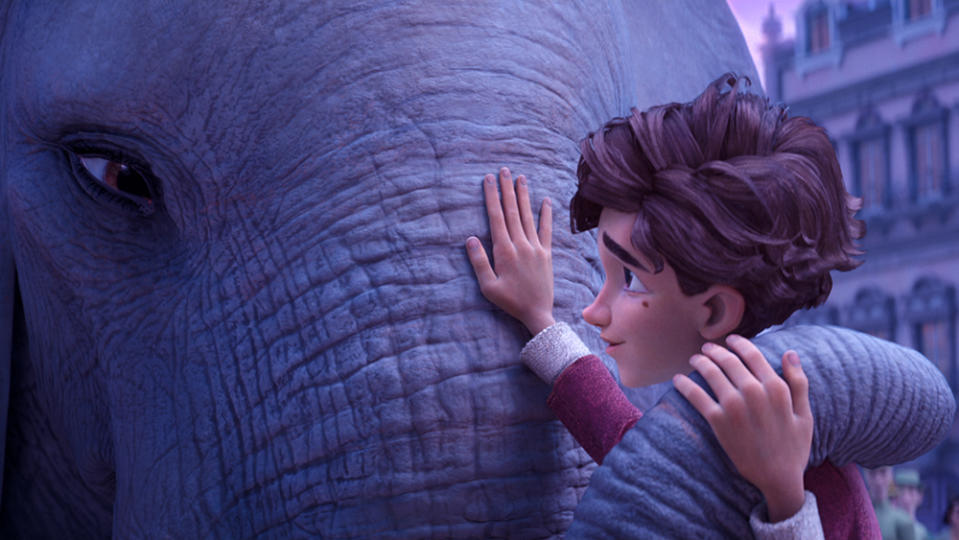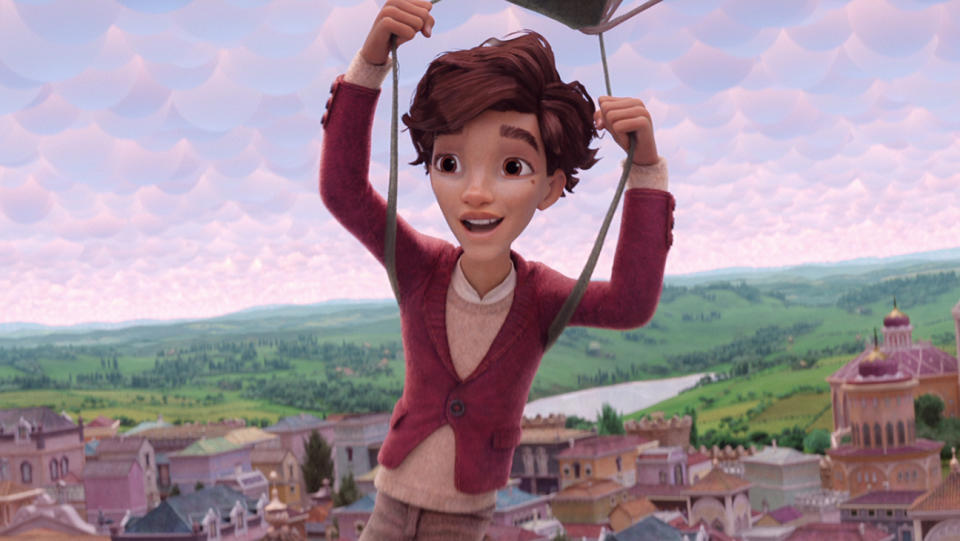‘The Magician’s Elephant’ Trailer Promises an Enchanting Adventure in Netflix Adaptation of Kate DiCamillo Fable (Exclusive)
- Oops!Something went wrong.Please try again later.

The first trailer for Netflix’s upcoming animated adventure The Magician’s Elephant teases an enchanting adaptation of Newbery-winning author Kate DiCamillo’s 2009 novel.
In a nearly two-minute first look at the animated feature premiering globally on March 17 and helmed by first-time director and animation and vfx veteran Wendy Rogers (Puss in Boots, The Chronicles of Narnia: Prince Caspian), the streamer promises an emotionally heartfelt and visually stunning coming-of-age fable about the desire to connect and belong, embracing possibility and the power of hope and compassion.
More from The Hollywood Reporter
“The first time I watched the movie, I was struck by the sheer beauty of it — it is a gorgeous film visually,” DiCamillo says of the Rogers-helmed adaptation. “But also, there is a real, genuine heart to the film. It is deeply moving. That is the true magic of it.”
Coming more than a decade after an adaptation was first announced with producer Julia Pistor attached — and just over a year after a musical stage adaptation made its debut at the Royal Shakespeare Company, the animated feature is led by a recognizable voice cast, which includes Brian Tyree Henry, Benedict Wong, Mandy Patinkin and Aasif Mandvi.
Noah Jupe voices the film’s lead character, a young orphan by the name of Peter who, while searching for his long-lost sister Adele (Pixie Davies), crosses paths with a fortune teller (Natasia Demetriou) in his town’s market square. Desperate to find the only family he has left, Peter asks her a singular but important question: is his sister still alive?
To uncover the answer, the young boy must find both a mysterious elephant — currently in the hands of nobility though seeking to be reunited with her own family — as well as the magician (Wong) able to conjure it. “This elephant will lead me to my sister,” Peter can be heard saying in the trailer. “I must ask you to give her to me.”
This ask sends the boy on a sweeping quest where he must complete three seemingly impossible tasks in exchange for the elephant. Armed with optimism, Peter sets out to achieve his own dream and in the process, may magically change the face of his town forever.
“For me, the heart of the movie and the book is the magic of well and truly connecting with others,” DiCamillo tells The Hollywood Reporter. “The Magician’s Elephant is a story about finding each other — finding love and forgiveness — against all odds.”
The latest big-screen adaptation from DiCamillo, the author behind The Tale of Despereaux and Because of Winn Dixie, the movie also counts Sian Clifford, Dawn French, Kirby Howell-Baptiste and Miranda Richardson among its voice cast. The Magician’s Elephant is produced by Julia Pistor (Jimmy Neutron, Lemony Snicket’s A Series of Unfortunate Events), written by Toy Story 4‘s Martin Hynes with computer imagery by Animal Logic.
THR spoke to the film’s director Rogers and producer Pistor about adapting it for the screen, COVID’s impact on the film’s long journey to completion and the significance of the movie’s female-led team.
What initially attracted you to this story? And what is the story’s creative heart for you irrespective of the medium?
Wendy Rogers: As I was reading The Magician’s Elephant, I fell in love with the characters, the themes and the fable tone! I was immediately captured by Peter — his determination and empathy — and I knew I had to help him find his sister. The book has a wonderfully lyrical, whimsical tone and Peter’s journey inspires hope and reconnection for the townspeople, reminding them that anything is possible. Martin Hynes’ script adaptation has incorporated additional compelling action and adventure in Peter’s journey to win the elephant and find his sister.
Julia Pistor: I loved the tone of the book — the combination of quirky, fun and exaggerated characters, poetic language and complex themes that Kate wove together. These qualities acted as organizing principles for us as we adapted the book into a screenplay. We worked to keep the same tonal balance — quirky comedy next to the poetic — as we realized the movie.
When reading the book for the first time, I was inspired by the unifying themes around the power of “what if.” I loved the story structure — a braid of people’s stories and aspirations that seem so disparate and yet come together in one big heartfelt and satisfying resolution at the end because of the brave and empathetic actions of the hero Peter. A great coming-of-age story — not just for Peter, but for the whole town. This is a creative heart for me.
This heart also inspired us to design a fresh group of characters that reflect the world and a fabled town that reflects its people. In working to be true to this heart we also had the opportunity to cast an incredible ensemble of actors. But, of course, the real heart is the elephant.

How else did you think about moving the story from page to screen? What were the things that felt essential to bring over?
Rogers: There were moments in the book that brought my heart into my throat. Gloria feeding Peter stew, realizing all the comfort and care that he has been missing in his life — it broke my heart in the best way. Peter’s empathy for the elephant when he looks into her eyes — another great lump in my throat! Of course, I want the audience to love these characters as much as I do. Resonant themes from the book remained north stars throughout the adaptation: believing in the impossible and taking action in that belief, the power of curiosity and asking “what if.” How can the world ever change if we do not question it?
Pistor: Translating a book into a film is challenging but rewarding. Not all books are structured to easily go onto the screen. One often has to invent additional material in order to deliver on the film experience versus the reader experience. This was true for The Magician’s Elephant. It is a glorious book but it does not really have a second act. For this reason, Martin invented the character of the King and with him some larger-than-life, almost impossible challenges that our hero needed to accomplish in order to win his prize and hopefully find his sister.
We were always conscious that the characters, action or restructuring that we did was in the tone of Kate DiCamillo’s original book — and in the tone of Kate DiCamillo in general. We are all huge Kate fans and we know she loves good comedy as much as she loves deep themes and real-world heart. Her ability to balance comedy and complex themes was something that was very important for us to emulate and keep.
It was very important to us that we keep much of the language of the narrator and many of the characters in our adaptation. The book has a special sauce in the use of language and it was important for us. In fact, the voice of the narration in the book is so important and unique that we created a character in the film to embody that.
How long did it take you to produce The Magician’s Elephant and were there any challenges to getting it completed?
Pistor: I first read the book in 2008 and developed it as a live-action film. The film didn’t get made, but I was committed to it for years believing deeply in the potential of Kate’s book and Martin Hyne’s adaptation. When I mentioned the script to Netflix in 2018, Melissa Cobb remembered reading the book to her daughter when she was a child. We decided together that the property would be best served in animation. Animation really allowed us to deliver on the nuanced themes and heart of the story while also delivering on the left-of-center comedy, characters and larger-than-life, whimsical adventure. Just as we were greenlit, however, we were sent home due to COVID! So, the biggest challenge was learning how to make this film remotely from our living rooms.
Rogers: COVID certainly presented a challenge for team collaboration. I missed being in the room with artists and animators, but it is amazing how we adapted to the forced remote working style and “zoom life.”
Why did you ultimately go with this art style for the film and what about it for you embodies and celebrates the genre, journey and characters of this story?
Rogers: I wanted a very physically grounded world and animation style for the surreal moments of magical realism to play against. We pushed the design to have patina and age — I have long been a fan of Rebecca Dautremer and our production designer Max Boas and I were very inspired by her gouache style and texturing. We really wanted to create a world that felt lived in and imperfect, with lost and found art techniques and visible brush strokes in the texturing.
Just before Netflix approached me to pitch for The Magician’s Elephant I had been on a trip driving around Ireland and coincidentally had taken so many photos of clouds. They are one of my favorite things to photograph! For our town living under clouds, I was inspired by the soft diffuse lighting of the midnight sun and the surreal ominous form of mammatus clouds. With these forms as inspiration, we stylized and designed the “boba” clouds for our film. The clouds are an important metaphor representing the loss of hope. We wanted to always feel their presence and surreal light but not have the world be gray and dark. Max and our art director Iuri Lioi designed a lighting scheme where the clouds capture the sunlight from above and change color based on the time of day, glowing at night from the solar power they’ve absorbed during [daytime].
Pistor: This story, from book to screen, has always embodied magical realism. But a challenge that we faced in animation is, what is magical realism in a world where anything is possible? We expect animals to fall from the sky in animation, so how do we create a world that feels real but also has the whimsy and magical realism to allow for the unexpected? Magical Realism is much easier in live-action. So I was smitten the first time I met Wendy and she expressed her vision for the film. There are only a handful of people within the animation community who would know how to take the watercolor look that she aspired to and translate it to 3D in a vibrant and contemporary manner.
Wendy Rogers is one of them and she assembled and led a remarkable team that delivered on the promise. The Guache look of the film provides a grounding reality while also allowing for flights of fancy and a surreal picture-book tone. Much of the story takes place under clouds that never “break.” It was a challenge to create a world under clouds that would not be sad and depressed and monochromatic. We needed a design that allowed us to show the world with sun before and after the clouds but that we would want to be under for the majority of the film. The art style chosen provided gorgeous color and texture and opportunity for lighting under the surreal clouds.

How did the female-led team assemble for this and do you feel like your perspective and your creative relationships strengthen what people will ultimately see on screen?
Rogers: When I first met Julia to pitch for the project, we realized we were very aligned in the emotional heart, themes and tone of The Magician’s Elephant. We have developed a strong friendship and creative partnership. Julia is a very experienced and remarkable producer. I’m incredibly grateful to have such an amazing producing partner for my first time directing.
Pistor: Kate DiCamillo has always been an advocate for female voices and was kind to let me be involved in taking her beautiful book and turning it into a movie. I think from the beginning we’ve aspired to have female leadership on the adaptation. It’s important to me as a producer to give women a voice in the movies I make. Netflix Animation was also very clear that they wanted to give women directors opportunity in their animated films and thus introduced me to Wendy early on. Wendy and I forged a partnership that I think is unique to two women working together as producer and director. I think we have shared experiences working in the industry — both positive and negative — and were able to support each other honestly because we spoke of these challenges honestly together. We were also able to have honest conversations with Netflix Animation leaders and our executives (who have been women) in the same manner.
It set a tone for the type of production we wanted, the type of communication we wanted among our teams. We pushed for a vulnerability that allowed for everyone to do their best work and be open to new ways of working and thinking. Many of our production leadership applied to work on our film —leaving other projects — because they wanted to work with Wendy, a female director, to support her in her first film and to learn from her as a leader in the industry. It was also important for us to mentor the women on the film, to share our experiences with them as they grow into the next generation of producers and directors. Everyone on this film, regardless of gender, brought heart and kindness to their work. That is not related to being a woman or a man. But there is no denying that qualities that are important to us as women leaders helped elevate the film.
Interview edited for length and clarity.

